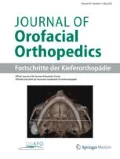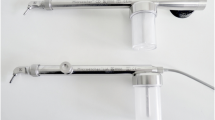Abstract
Objectives
Selected combinations of materials were used to create tooth–adhesive–bracket complexes to evaluate shear bond strength (SBS) and the adhesive remnant index (ARI) with regard to enamel sealing.
Methods
Four adhesive systems also appropriate for use as enamel sealants were combined with four bracket types, resulting in 16 adhesive–bracket combinations, each of which was tested on 15 permanent bovine incisors. Sealant–adhesives included two recently introduced fluoride-releasing systems (Riva bond LC® and go!®), one established primer (Opal® Seal™), and one commonly used adhesive as control (Transbond™ XT). Brackets included two metal (discovery® by Dentaurum and Sprint®) and two ceramic (discovery® pearl and GLAM®) systems. After embedding the bovine teeth, bonding the brackets to their surface, and storing the resultant samples as per DIN 13990-2 with modifications, an SBS test was performed by applying the shear force directly at the bracket base in an incisocervical direction. Then the ARI scores were determined.
Results
Discovery® + Transbond™ XT yielded the highest (47.2 MPa) and GLAM® + go!® the lowest (17.0 MPa) mean SBS values. Significant differences (p < 0.0001) were found between metal and ceramic brackets of the same manufacturers (Dentaurum and Forestadent). Our ratings of the failure modes upon debonding predominantly yielded ARI 0 or 1. The high SBS values and low ARI scores observed with discovery® + Transbond XT™ were reflected in a high rate of enamel fracture, which occurred on 11 of the 15 tooth specimens in this group.
Conclusions
All sealant–bracket combinations were found to yield levels of SBS adequate for clinical application. SBS values and ARI scores varied significantly depending on which sealant–brackets were used.
Zusammenfassung
Zielsetzung
Ziel dieser Studie war die Untersuchung der Scherhaftfestigkeit und des ARI (Adhesive Remnant Index) für ausgewählte Materialkombinationen in Abhängigkeit von der Art der Glattflächenversiegelung.
Material und Methodik
Es wurden folgende Materialkombinationen (16 Gruppen zu je 15 Proben) auf permanenten Rinderschneidezähnen untersucht: 1. Glattflächenversiegler: Opal® Seal™ (Opal Orthodontics, South Jordan, UT, USA), Riva bond LC® und go!® (beide SDI Ltd, Bayswater, Victoria, Australien) sowie Transbond™ XT (3 M Unitek, Monrovia, CA, USA); 2. Bracketsysteme: discovery®, discovery® pearl (beide Dentaurum, Ispringen, Deutschland), GLAM® und Sprint® (beide Forestadent, Pforzheim, Deutschland). Die Rinderzähne wurden in Anlehnung DIN 13990-2 eingebettet, beklebt und gelagert. Es folgte der Abscherversuch in einer Werkstoffprüfmaschine (Zwick, Ulm, Deutschland) mit einer von okklusal nach gingival wirkenden Scherkraft direkt an der Bracketbasis. Anschließend wurde der ARI bestimmt.
Ergebnisse
Die größte Scherhaftfestigkeit (Mittelwerte) ergab die Kombination aus discovery® und Transbond™ XT (47,2 MPa), die geringste die Kombination aus GLAM® und go!® (17 MPa). Je nach Brackettyp ergaben sich bei beiden Herstellern (Dentaurum und Forestadent) signifikante Unterschiede (p < 0,0001) in den Messwerten der Metall- und Keramikbrackets. Es zeigten sich überwiegend ARI-Grade von 0 und 1. Aufgrund hoher Scherfestigkeit und niedriger ARI-Grade kam es vor allem in der Kombination Transbond™ XT mit dem Metallbracket discovery® zu Schmelzrissen (11/15 Zähnen).
Schlussfolgerung
In der vorliegenden Untersuchung wurde bei allen untersuchten Glattflächenversiegler-Bracket-Kombinationen eine ausreichende Scherhaftfestigkeit für den klinischen Einsatz festgestellt. Sowohl die Auswahl des Glattflächenversiegelungssystems als auch die des Brackets hat signifikanten Einfluss auf die Scherfestigkeit und das Abscherverhalten (ARI).





Similar content being viewed by others
References
Artun J, Bergland S (1984) Clinical trials with crystal growth conditioning as an alternative to acid-etch enamel pretreatment. Am J Orthod 85:333–340
Bassiouny MA, Grant AA (1978) A visible light-cured composite restorative. Clinical open assessment. Br Dent J 145:327–330
Brantley WA, Eliades T (2001) Enamel etching and bond strength. In: Brantley WA, Eliades T (eds) Orthodontic materials. Scientific and clinical aspects. Georg Thieme Verlag, Stuttgart, New York: 143–169
Buonocore MG (1955) A simple method of increasing the adhesion of acrylic filling materials to enamel surfaces. J Dent Res 34:849–853
DIN13990-2 (2009) Zahnheilkunde—Prüfverfahren für die Scherhaftfestigkeit von Adhäsiven für kieferorthopädische Befestigungselemente—Teil 2: Gesamtverbund Befestigungselement-Adhäsiv-Zahnschmelz. Beuth Verlag, Berlin
Dominguez G, Tortamano A, Lopes LV et al (2013) A comparative clinical study of the failure rate of orthodontic brackets bonded with two adhesive systems: conventional and self-etching primer (SEP). Dental Press J Orthod 18(2):55–60
Dubey R, Choukse A, Bharadia A (2011) Enamel demineralization following orthodontic treatment. Guident 4(11):40–45
Faria-Junior EM, Guiraldo RD, Berger SB et al (2015) In-vivo evaluation of the surface roughness and morphology of enamel afater bracket removal and polishing by different techniques. Am J Orthod Dentofac Orthop 147:324–329
Holzmeier M, Schaubmayr M, Dasch W et al (2008) A new generation of self-etching adhesives: comparison with traditional acid etch technique. J Orofac Orthop 69:78–93
Knox J, Jones M, Hubsch P et al (2000) An evaluation of the stresses generated in a bonded orthodontic attachment by three different load cases using the finite element method of stress analysis. J Orthod 27:39–46
Klocke A, Kahl-Nieke B (2006) Effect of debonding force direction on orthodontic shear bond strength. Am J Orthod Dentofac Orthop 129:261–265
Kohda N, Iijima M, Brantley W et al (2012) Effects of bonding materials on the mechanical properties of enamel around orthodontic brackets. Angle Orthod 82:187–195
Lodaya SD, Keluskar KM, Naik V (2011) Evaluation of demineralization adjacent to orthodontic bracket and bond strength using fluoride-releasing and conventional bonding agents. Indian J Dent Res 22:44–49
Mandall NA, Millett DT, Mattick CR et al (2002) Orthodontic adhesives: a systematic review. J Orthod 29:205–210
Mojtahedzadeh F, Akhoundi MS, Noroozi H (2006) Comparison of wire loop and shear blade as the 2 most common methods for testing orthodontic shear bond strength. Am J Orthod Dentofac Orthop 130:385–387
Nakamichi I, Iwaku M, Fusayama T (1983) Bovine teeth as possible substitutes in the adhesion test. J Dent Res 62:1076–1081
Newman GV (1965) Epoxy adhesives for orthodontic attachments: progress report. Am J Orthod 51:901–912
Nguyen TT, Miller A, Orellana MF (2011) Characterization of the porosity of human dental enamel and shear bond strength in vitro after variable etch times: initial findings using the BET method. Angle Orthod 81:707–715
Oesterle LJ, Shellhart WC, Belanger GK (1998) The use of bovine enamel in bonding studies. Am J Orthod Dentofac Orthop 114:514–519
Pickett KL, Sadowsky PL, Jacobson A et al (2001) Orthodontic in vivo bond strength: comparison with in vitro results. Angle Orthod 71:141–148
Pseiner BC, Freudenthaler J, Jonke E et al (2010) Shear bond strength of fluoride-releasing orthodontic bonding and composite materials. Eur J Orthod 32:268–273
Reimann S, Mezey J, Daratsianos N et al (2012) The influence of adhesives and the base structure of metal brackets on shear bond strength. J Orofac Orthop 73:184–193
Reynolds IR (1975) A review of direct orthodontic bonding. Br J Orthod 2:171–178
Richter C, Jost-Brinkmann PG (2015) Shear bond strength of different adhesives tested in accordance with DIN 13990-1/-2 and using various methods of enamel conditioning. J Orofac Orthop 76:175–187
Rosentritt M, Behr M, Hofmann E, Handel G (2002) In vitro wear of composite veneering materials. J Mat Sci 37:425–429
Sfondrini MF, Scribante A, Cacciafesta V et al (2011) Shear bond strength of deciduous and permanent bovine enamel. J Adhes Dent 13:227–230
Sorel O, El Alam R, Chagneau F et al (2002) Comparison of bond strength between simple foil mesh and laser-structured base retention brackets. Am J Orthod Dentofac Orthop 122:260–266
Tavas MA, Watts DC (1979) Bonding of orthodontic brackets by transillumination of a light activated composite: an in vitro study. Br J Orthod 6:207–208
Thomas RL, de Rijk WG, Evans CA (1999) Tensile and shear stresses in the orthodontic attachment adhesive layer with 3D finite element analysis. Am J Orthod Dentofac Orthop 116:530–532
Yassen GH, Platt JA, Hara AT (2011) Bovine teeth as substitute for human teeth in dental research: a review of literature. J Oral Sci 53:273–282
Zachrisson BJ (1977) A posttreatment evaluation of direct bonding in orthodontics. Am J Orthod 71:173–189
Acknowledgements
The authors wish to thank Dentaurum (Ispringen, Germany), Forestadent (Pforzheim, Germany), and Ortho Service (Wörrstadt, Germany) for their kind support of our study. They are grateful to Dr. Helmut Schlumprecht for statistical counseling.
Author information
Authors and Affiliations
Corresponding author
Ethics declarations
Conflict of interest
E Hofmann, L. Elsner, U. Hirschfelder, T. Ebert, and S. Hanke declares no conflict of interest for herself and her co-authors.
This article does not contain any studies with human participants or animals performed by any of the authors.
Additional information
PD Dr. Elisabeth Hofmann.
Rights and permissions
About this article
Cite this article
Hofmann, E., Elsner, L., Hirschfelder, U. et al. Effects of enamel sealing on shear bond strength and the adhesive remnant index. J Orofac Orthop 78, 1–10 (2017). https://doi.org/10.1007/s00056-016-0065-x
Received:
Accepted:
Published:
Issue Date:
DOI: https://doi.org/10.1007/s00056-016-0065-x




